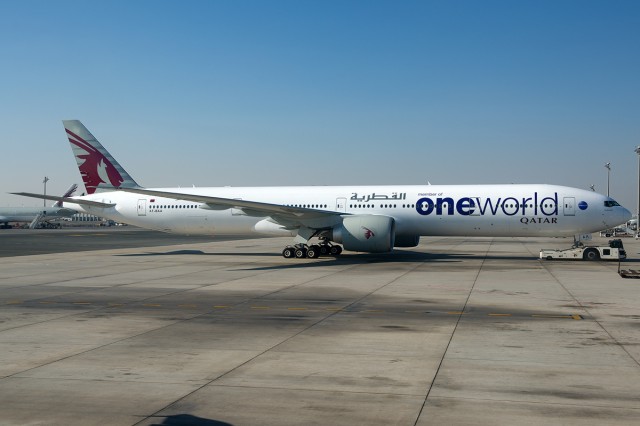
One of Qatar’s two 0neworld 777s viewed from the window of a QR A320 – Photo: Bernie Leighton | AirlineReporter
A few days before departing for Warsaw, I had a stark realization – I actually had no reason to be in Poland other than a milage run. Polish Christmas is not what we are familiar with here in North America. Indeed, the idea of potentially-radioactive Belorussian carp as my main feast for such a joyous occasion caused me some dismay. I admit, there are plenty of amazing things to do in Poland (including two great military and aviation museums) – just not on Christmas Eve or Christmas Day. Both days, the entire country – including the trains – more or less grinds to a halt.
Now, I could have spent a couple of days in a hotel in downtown Warsaw, and maybe gone shopping before my return home. But practicality is not, and never will be, how I solve problems. My original goal was to fly on Biman’s DC-10 from Kuala Lumpur back to Dacca, but I couldn’t make the times work. After a call with my usual travel agent (who has come to understand that I have a flare for the weird), I discovered that I could, within the window of my original British Airways fare to and from Poland go on a day trip to Singapore! I also had another goal – could I do it for a similar cost to a week of peak rate hotel time at a luxury hotel in Warsaw? Thanks to Polish currency (3 Zloty =1 USD) I could, and what an itinerary I booked!
We at AirlineReporter have always been fans of Qatar Airways; it was high time I found out what the fuss was about, starting with their Airbus narrow-body fleet. To say the least, I was excited. I had heard nothing but great things about Qatar’s business class from our other staff members. I am, probably, the harshest and most pedantic critic on the AirlineReporter staff. If you are already bored of the article, I can summarize my experience with QR in one word. AMAZING! If you are interested in why, please do continue.
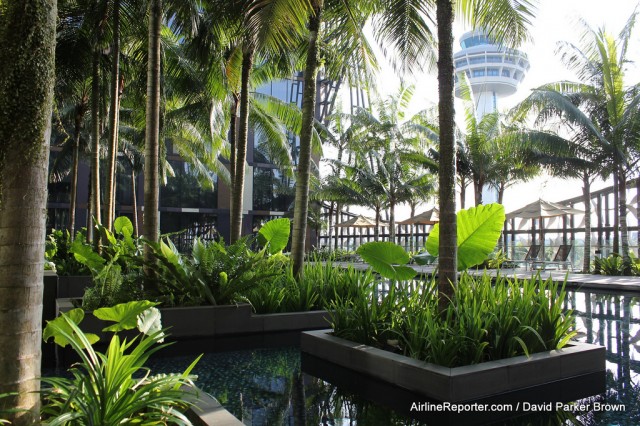
A very cool (and green) pool at the Crowne Plaza
STAYING AT THE CHANGI AIRPORT
This is a continuation of Flying Over 21,000 Miles to Singapore in Four Days – Who Needs Sleep? Part 1…
I had just flown about 18 hours non-stop from LA to Singapore, it was 5am local time, and I had about 30 hours on the ground before I headed back to the states on the world’s longest flight. I wasn’t sure if I was going to head out to Singapore or stick to the airport during my “layover.”
Since I was exhausted, not feeling too well, and knew the Changi Airport (SIN) had quite a bit to offer, I ended up never leaving the airport. Yes, my name is David and I am an #AvGeek.
Singapore Airlines gave a special tour to invited media guests to their training facility located in Singapore and I felt privileged to be among the group. We were able to experience the flight attendant safety training, cabin crew procedure training and the flight simulators.
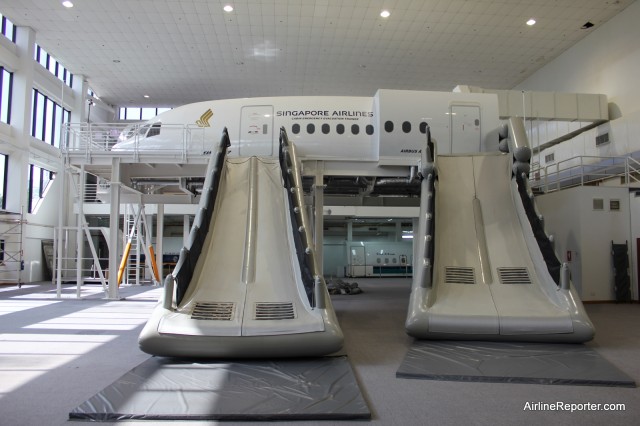
The slides are not for fun. This hybrid of Boeing 777 and Airbus A380 is to teach cabin crew how to evacuate an airplane.
We first entered a large room that looked almost like a play ground with slides, but it was all business. This is where cabin crew learn and get re-trained on safety protocols. There were a number of different interior mock ups and the most interesting was the hybrid slide trainer. This was a unique set up with a Boeing 777 in the front and an Airbus A380 in the rear. The aircraft is used to allow flight attendants to practice evacuating passengers and jumping down the slides themselves. Inside the mock up, the interior was made up of earth-toned seats, with half of it being wider than the other half. The emergency doors had LCD screens located in the windows to simulate what might be on the other side (ie fire, debris) and the flight crew must react accordingly. Other mock ups in the facility allow cabin crew to practice opening emergency doors, escape from crew quarters and learn the proper operations on different aircraft.
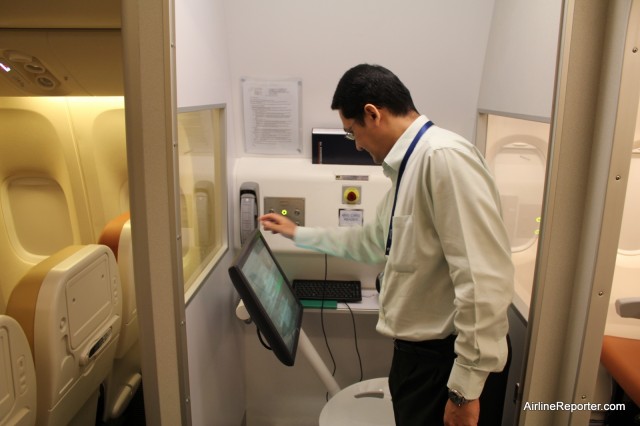
Instructors are able to set up a number of different scenarios for flight attendant training.
The larger hybrid airline cabin is able to be filled with smoke to simulate an emergency situation (see an example from when I visited AirTran). There is a control panel that lets the instructor set up a scenario and the flight attendants must react accordingly. I was hoping to have an opportunity to take a slide down, but decided on the stairs instead.
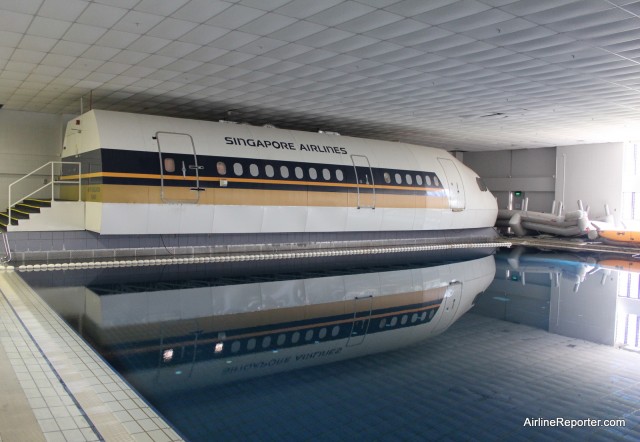
The water is calm in this photo, but during training, instructors can make waves in the Singapore Airlines training pool.
After coming down the stairs, we went into the pool training facility, where flight crew are required to practice jumping into the water with their uniforms. The pool is able to simulate waves and rough conditions, providing an additional challenge for the new trainees. Much like the slide trainer, the interior has a full cabin set up, giving as much realism as possible to an actual water landing event.
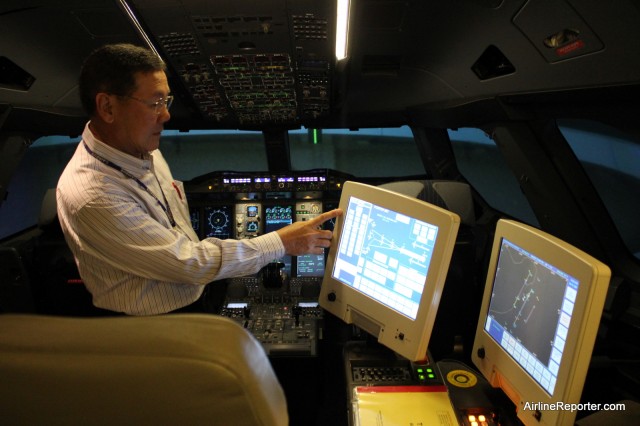
Singapore Airline's Airbus A380 flight simulator has a Star Trek like command chair for the instructor to create almost any scenario possible.
The training facility also operates seven aircraft simulators that cost between $12million and $30million. Singapore Airlines leases time on the simulators for other airlines as well, except the Airbus A380 since they need all the time on it as possible. The A380 simulator is unsurprisingly big and although it is a massive beast — she flies like a champ. The simulators have full motion giving pilots realistic g-forces during landing, take off and maneuvers. Instructors are able to sit in a command seat behind the pilot and co-pilot to create dangerous situations at airports around the globe. Before pilots take a spin on the larger simulator, they are able to practice the proper procedures on a much more simplistic (and cheaper) Flight Training Device.
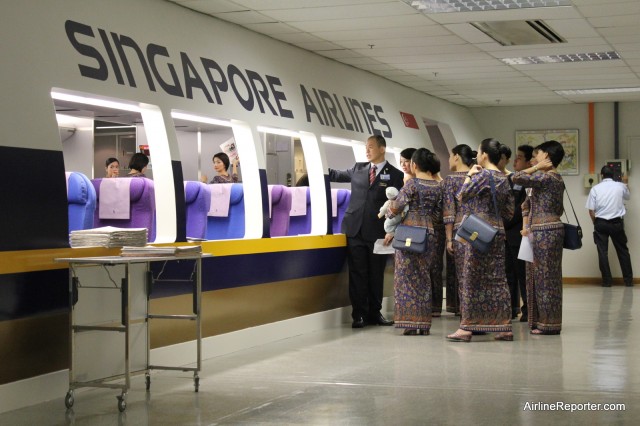
New Singapore Girls learn how to work the economy section at the training facility.
Even though safety is the most important aspect of a flight attendants job, a large portion of the facility is set up to teach flight attendants how to take care of their customers. Down a long hallway, there are multiple mock-ups to let new employees learn customer service for economy, business and first class passengers. Interestingly, part of their training includes greeting facility guests with a warm welcome. It is quite impressive to walk by a group of 25+ new flight attendants and have them all welcome you to the training center.
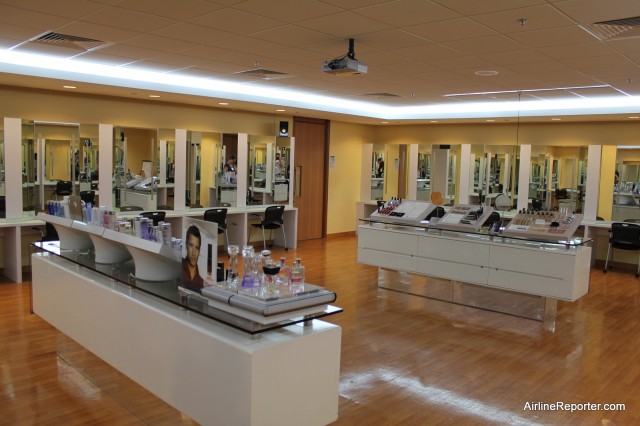
Looks and proper grooming is important to Singapore Airlines. This room, new hires learn how to look professional during long flights in a low-humidity environment.
First impressions are important and Singapore Airlines makes sure their entire flight crew look professional. Even though the male crew won’t be wearing any make-up, they still go through the full training to learn how to keep their skin from getting too dry and how to assist their female co-workers. There is a classroom dedicated to make-up and scents training and another for flight attendants to practice walking properly.
Singapore Airlines is known for their high-end service and it takes quite a bit of work to accomplish. Besides basic training, flight crew are required to return for additional and advanced training. Even though the facility might look like fun and games, everything done there is for either customer service or safety. Both are very important aspects to running a successful airline and it seems to be working quite well for Singapore Airlines.
CHECK OUT ALL 30 PHOTOS OF SINGAPORE AIRLINES TRAINING FACILITY







